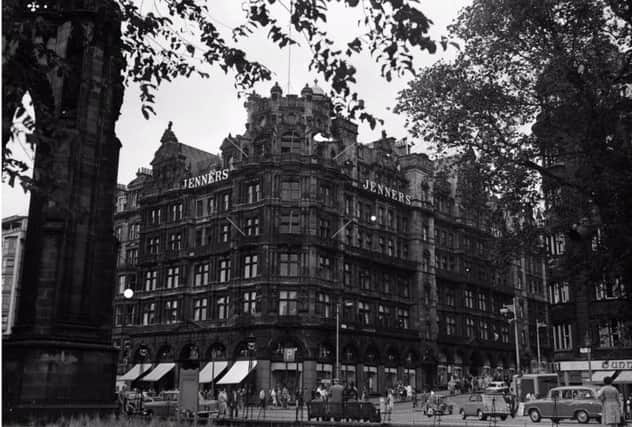Scottish fact of the day: Jenners Department Store


History
The store has maintained its position on the corner of Princes Street towards the east end since Charles Jenner and Charles Kennington took over the lease on 47 Princes Street, in 1838.
Their goal was to provide Edinburgh residents with the finest silks and linens - previously only sold in the fashion houses of London.
Advertisement
Hide AdBy 1860, the store had subsumed 48 Princes Street, as well as Nos. 2, 4, 6 and 8 on South St David’s Street.
Initially named Kennington & Jenner, the store was for many years run by the Douglas-Miller family, descendants of James Kennedy who took charge of the store in 1881.
By the time 1890 came around, Charles Jenner & Co. had expanded to 49 Princes Street as well as adding Nos. 10, 12, 14 and 16 on South St David’s Street, marking it out as the largest store in Scotland.
The original buildings forming the department store were destroyed in a fire in November 1892, with the Jenners factory on Rose Street adapted into a temporary store as a result.
Celebrated Scottish architect William Hamilton Beattie - responsible for designing the Balmoral Hotel, the Carlton Hotel and Cowan’s Warehouse on West Register Street - was appointed in 1893 to design the new store.
Charles Jenner, however, died in October of 1893, and never got to see the redesigned store, which opened in March 1895.
Advertisement
Hide AdA codicil in Jenner’s will bequeathed £8,000 to the external renovations to the exterior, including the provision of the building’s caryatids - sculpted female figures taking the place of supporting columns or pillars - to ‘show symbolically that women are the support of the house’.
The new store, designed by Beattie, contained a number of technical innovations such as electric lighting, air conditioning and hydraulic lifts, and to this day is a designated Category A listed building.
Advertisement
Hide AdThe company bought the old Edinburgh Stock Exchange in 1903, and revamped it as part of the department store, extending Jenners up to Rose Street.
Further refurbishments in 1922 took the frontage to 52 Princes Street, and in 1962, the building on the south side of Rose Street was knocked down (including the infamous Crane’s Bar) and a modern building was built for Jenners on the same site.
In 2002, the store underwent a revamp, culminating in new windows along Princes Street designed to ape the 1895 appearance and the removal of the white canopies.
‘Harrods of the North’
Jenners has held a Royal Warrant since 1911, and is often referred to as the ‘Harrods of the North’. Royal Warrants have been issued to tradespeople or businesses supplying goods or services to the royal court for centuries, lending prestige to the supplier.
Warrants granted by members of the British royal family tend to carry the phrase ‘By Appointment to...’ followed by the title and name of the royal customer followed by whatever goods are provided.
Queen Elizabeth II visited Jenners as it celebrated its 150th anniversary in 1988.
Advertisement
Hide AdIn 2004, shortly before its takeover by House of Fraser, Jenners altered its vision statement from its aim to ‘be the most exciting department store outside of London’ to ‘Confidently independent’.
House of Fraser acquisition
In 2005, it was announced that the Douglas-Miller family had held talks to sell the business to the House of Fraser, for a price between £100 million and £200 million, although it was eventually sold for £46.1 million in April 2005.
Advertisement
Hide AdIn August of that year, the lease of the building was sold to Moorcroft Capital Management - owned by ex-Jenners chief executive Robbie Douglas-Miller - having remained with the Douglas-Miller-owned Jenners holding company, JPSE Ltd.
Jenners kept its identity, despite the House of Fraser’s tendency to rebrand other acquisitions.
In 2008, £3 million of improvements to the store were made.
Other stores
While previously owning Jenners outlets in both Edinburgh and Glasgow Airports, the firm took the decision to close these shops in April 2007. Jenners had said that security measures introduced following the 2006 transatlantic aircraft plot had led to a marked downturn in sales at the stores.
It maintains a store in Alexandria, near Loch Lomond.
Popular culture
The famous Jenners windows can possibly be seen in Sylvain Chomet’s animated film The Illusionist. Partly set in Edinburgh in 1959, a department store with white canopies is in the background of several scenes and given the shop’s position, it is likely that it is either modelled on, or intended to be the iconic department store.
Christmas tree
The Jenners Christmas Tree is something of an Edinburgh institution. Standing 40ft tall, the store abandoned using a real tree in 2004, but reversed the decision in 2007.
Advertisement
Hide AdThe tree is normally a Norwegian spruce from the Duke of Buccleuch’s estate in the Borders, and is decorated with thousands of lights and baubles.
It’s not unheard of for the tree to be given a police escort because of its size, and is usually on display from early November to late December.